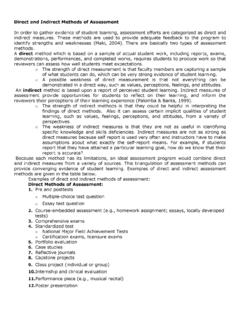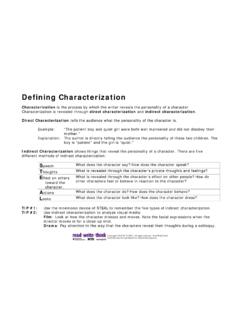Transcription of Indirect tax 2015 low-res - EY - United States
1 Indirect tax in 2015A review of global Indirect taxdevelopments and issues Gijsbert BulkGlobal Director of Indirect TaxTel: +31 88 40 71175 Email: taxation in 2015 Our thoughts on2 Indirect tax in 2015 The changes presented, covering more than 100 jurisdictions, have either been introduced in recent months or are expected in 2015 and beyond. Four summary maps are also included to provide a snapshot of where the changes are taking produce Indirect Tax in 2015 because our clients tell us that it is a valuable resource. We know that if you manage Indirect taxes, one of the biggest challenges you face is how to keep pace with the vast number of legislative changes that happen every year. We hope that the detailed changes in this annual guide can help you to pinpoint which ones are most relevant for your business and where you may need to take action. Further, by bringing these developments together, and by identifying key policy trends, we hope to help you consider how these Indirect tax changes may have an impact on your overall tax position and business strategy.
2 As in previous years, our lead article examines the key Indirect tax trends that we are seeing around the world and their implications for global businesses. We see the continued spread of VAT and GST systems, increasing rates for VAT/GST and excise duties (although the raises in VAT/GST rates are not as steep as in previous years), the introduction of new Indirect taxes (such as on health-related products), the continued introduction of new free trade agreements and customs cooperation agreements as well as the adoption of many trade restricting ] Ydkg [gfka\]j l`] ka_fa [Yfl aehY[l l`Yl [`Yf_]k af l`] world of business and developments in technology are having on Indirect tax policies. New rules regarding the taxation of the digital economy have been introduced or are expected in many jurisdictions, including Albania, the European Union, Japan, South Africa, South Korea and the United States .
3 Developments in technology are also changing how tax authorities conduct their business e-audits are becoming the norm, and many bmjak\a[lagfk Yj] eYcaf_ ]%afnga[af_ Yf\ ]% daf_ eYf\Ylgjq for of these trends have been emerging for several years, but the sheer number of changes associated with them means that keeping abreast of new legislation, regulations and opportunities [gflafm]k lg [`Ydd]f_] l`] fYf[]$ lYp Yf\ ljY\] ^mf[lagfk g^ businesses of all sizes and operating in all tax in 2015 hjgna\]k Y `a_`%d]n]d gn]jna]o g^ ka_fa [Yfl developments in Indirect taxation around the globe, but it is not an exhaustive review. Indirect taxation changes rapidly, so please be aware that there may be other changes not listed in this publication that may have an impact on your business. Detailed information about developments in Indirect taxes may be found at , particularly via our global tax alerts library ( ) and through our regularly updated eVA information service; in The Worldwide VAT, GST and Sales Tax Guide; and in our regular magazine, Af\aj][l LYp :ja] you would like to discuss developments in Indirect tax, or if you would like access to our eVA service or copies of our publications, please contact one of the EY Indirect Tax leaders listed in this report, or your usual EY Indirect Tax to Indirect tax in 2015, our latest annual roundup of developments in value-added tax (VAT), goods and services tax (GST), consumption taxes, excise duties, customs duties and other Indirect taxes around the world.
4 Best regards,Gijsbert BulkGlobal Indirect Tax Indirect tax in 2015 3Co4 Indirect tax in 2015123VA T/ G ST 18 Indirect tax developments in 2015 and beyond 6 VAT/GST rate changes map 20 Other VAT/GST changes map 22 VAT/GST changes 24 Excise and other Indirect taxes 68 Excise and other taxes map 70 Excise and other Indirect tax changes 72 Global trade 90 Global trade free trade agreements map 92 Free trade agreements 94Ka_fa [Yfl [gmfljq \]n]dghe]flk 96ontentsFour trends that shape the global Indirect tax landscape 7 Indirect tax in 2015 5 Indirect tax developments in 2015 and beyondThe Indirect tax world is in constant motion. What was true yesterday or even today may prove to be wrong tomorrow. Ignoring recent developments in Indirect taxes or not being compliant with Indirect lYp gZda_Ylagfk `Yk \] fal]dq Z][ge] Yf ]ph]fkan] oversight for companies of all sizes, whether they are active in the local market or on a global level.
5 This article discusses the latest trends and developments in Indirect tax around the world and what business leaders should watch out for in 2015 and beyond. Claudio FischerTel: +41 58 286 3433=eYad2 [dYm\ag& k[`]j8[`&]q&[geClaudio Fischer is a member of EY s Indirect Tax Policy team. Based in Zurich, he advises clients on the effective and strategic engagement of tax policy-makers to shape policy \]n]dghe]fl Yf\ af m]f[] Yf\ effect Indirect tax in 20156 Indirect tax in 2015 Four trends that shape the global Indirect tax landscape:0102 03 04 Indirect taxes continue to grow while direct taxes stagnate:VA T/ G ST sys te m s are spreading, VAT/GST rates are rising and excise taxes are increasing on an almost global scale. Indirect taxes are adapting to new economic realities: E-commerce and virtual currencies are on the radar of an increasing number of governments, and they are adapting their tax systems to capture these global trade landscape is changing fast: Global trade continues to grow but still faces trade restrictive measures in many regions of the world.
6 Tax authorities are focusing on enforcement of Indirect taxes: New tools and rules are simplifying tax authorities access to taxpayer data and increasing the ^j]im]f[q$ ]^ [a]f[q and effectiveness of tax tax in 2015 7 Indirect tax in 2015 7 Indirect taxes continue to grow while direct taxes stagnateAf l`] Y^l]jeYl` g^ l`] fYf[aYd [jakak$ governments in many countries still have a strong need for cash. Whether the f]]\ ak lg fYf[] lYj_]l]\ klaemdYlagf programs for the economy, or whether it is to generally make up for the gaps left behind by a shrinking economy, Indirect lYp]k `Yn] hjgn]f lg Z] l`] jkl [`ga[] for generating revenue for a number of years. And they continue to trend can be explained with the large number of prominent advocates who all promote the shift from direct to Indirect taxes, such as the International Monetary Fund (IMF), the Organisation for Economic Co-operation and Development (OECD) and the European Commission.
7 A number of international studies have indicated that value-added taxes (VAT) have the least impact on growth, while corporate income taxes have a negative impact on equally strong reason for this ongoing development is that international tax competition and the weakened economy simply do not allow for ever-increasing corporate or personal income taxes. Af\aj][l lYp]k$ o`a[` Zq l`]aj \] falagf are borne by the consumer and do not j]dq gf hjg lk$ Yj] em[` d]kk Y^^][l]\ by these changes. In this context, the results of a recent research paper on the tax situation of the 28 European Union Member States2 are striking: they increased their VAT rates at the same pace as they reduced their corporate and personal income tax rates (see Figure 1).Figure 1. Evolution of standard VAT rates and of the top personal income tax (PIT) and corporate income tax (CIT) rates in the EU-28 (simple arithmetic average)31.
8 Taking stock of reform action and identifying priorities in 2013 chapter as part of Economic Policy Reforms *()+2 ?gaf_ ^gj ?jgol` (OECD Publishing, 2013).2. Austria, Belgium, Bulgaria, Croatia, Republic of Cyprus, Czech Republic, Denmark, Estonia, Finland, France, Germany, Greece, Hungary, Ireland, Italy, Latvia, Lithuania, Luxembourg, Malta, Netherlands, Poland, Portugal, Romania, Slovakia, Slovenia, Spain, Sweden and the UK. 3. A wind of change? Reforms of Tax Systems since the launch of Europe 2020, European Commission tax paper number 49, , p. 6, 9 February : European Commission. 2014 Standard VAT rate2000200220042006200820102012201422%2 1%20%19%18%Top PIT rate46%44%42%40%38%36%200020022004200620 08201020122014 Top CIT rate33%31%29%27%25%23%21%200020022004200 620082010201220148 Indirect tax in 2015 Figure 2. Average standard VAT rate in the 28 EU Member States and the OECD Member Countries4In practice, we can see three main ways that Indirect taxes are used to generate more revenue:1.
9 VAT/GST systems are to the OECD s Consumption Tax Trends 2014, 164 countries in the world levied a VAT as of 1 January 2014: 46 in Africa, 1 in North America, 18 in Central America and the Caribbean, 12 in South America, 28 in Asia, 51 in Europe, and 8 in Oceania. As a result, only a minority of countries now apply retail sales taxes, , single-stage taxes gf _gg\k Yf\ k]jna[]k kmhhda]\ Zq fYd consumers. Furthermore, the number of VAT countries continues to grow, especially in emerging economies. Effective 1 January 2015, VAT was introduced in the Bahamas. Effective 1 April 2015, a GST will be implemented in Malaysia to replace the existing sales and services tax. Egypt is introducing a VAT law that will replace the existing general sales tax system. Suriname is also expected to replace the current Turnover Tax with a VAT system from 1 January 2016. Last year, the Government of Puerto Rico commissioned a task force to develop a tax reform package that would increase general fund revenue, simplify overall compliance and promote economic growth.
10 Among the reforms discussed in the tax reform package was the implementation of a VAT system. H]j`Yhk egkl ka_fa [Yfldq$ Af\aY eYq also soon join the VAT club. The Indian Government has been working on replacing the current Indirect tax regime with a comprehensive GST, with a current proposed date for introduction of 1 April 2016. If GST implementation goes ahead, l`ak oadd Z] Y ka_fa [Yfl \]n]dghe]fl given the size of the Indian economy. 2. VAT/GST rates are countries where a VAT/GST already exists, average VAT/GST rates have increased in recent years, and those increases seem set to continue. This upward rate trend is particularly true for Europe and the OECD countries, where the average standard VAT rate has now reached (EU Member States ) and (OECD Member Countries) compared with and average rates, respectively, before the crisis in to previous years, the rates in Europe have been surprisingly stable at the start of 2015, although they remain high.

















